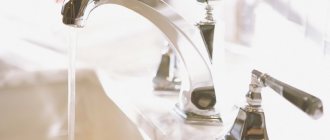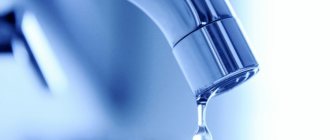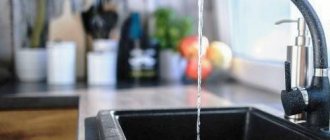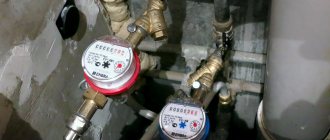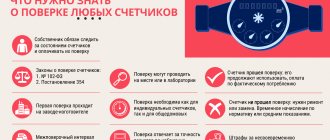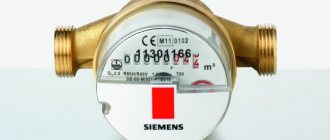The temperature of cold water in the tap is measured with a simple water thermometer. It only takes a few minutes to do this. This information will be especially useful for those who are planning to purchase instantaneous heaters or are using expensive plumbing equipment to modernize their bathroom or toilet.
It is advisable to limit the optimal water temperature in the tap that supplies cold water. This is required for minimal wear of heating and water supply units and devices.
The use of superheated liquid in cold water supply pipes can accelerate destructive processes associated with the impact on the surface of pipes and mixers. And supercooled water, which is supplied through an incorrectly designed or constructed water supply system, can lead to freezing and, ultimately, to expensive repairs.
Dear readers!
Our articles talk about typical ways to resolve legal issues, but each case is unique. If you want to find out how to solve your specific problem, please contact the online consultant form on the right →
It's fast and free!
Or call us by phone (24/7):
If you want to find out how to solve your particular problem, call us by phone. It's fast and free!
+7 Moscow,
Moscow region
+7 Saint Petersburg,
Leningrad region
+7 Regions
(free call for all regions of Russia)
Cold water temperature in the tap
Clause 10.11 #8212 Chapter 10 Hydraulic mode
The value of water pressure in the return pipelines of water heating networks of open heating systems during the non-heating period, as well as in the supply and circulation pipelines of the hot water supply network should be taken to be 0.05 MPa more than the static pressure of hot water supply systems to consumers.
Clause 16.17 #8212 Chapter 16 Heating points
Water treatment should not worsen its sanitary and hygienic indicators. Reagents and materials used for water treatment and having direct contact with water entering the hot water supply system must be approved by the Ministry of Health of Ukraine for use in domestic and drinking water supply systems.
SNiP 2.04.01 Internal water supply and sewerage of buildings
Clause 2.1 #8212 Chapter 2 Quality and temperature of water in water supply systems
The quality of cold and hot water supplied for household and drinking needs must comply with GOST 2874-82. The quality of water supplied for production needs is determined by technological requirements.
Clause 2.2 #8212 Chapter 2 Quality and temperature of water in water supply systems
The temperature of hot water at water intake points should be provided:
- a) not lower than 60 C - for centralized hot water supply systems connected to open heating systems
- b) not lower than 50 C - for centralized hot water supply systems connected to closed heat supply systems
- c) not higher than 75 C - for all systems specified in subparagraphs “a” and “b”.
Clause 2.3 #8212 Chapter 2 Quality and temperature of water in water supply systems
In the premises of preschool institutions, the temperature of hot water supplied to the water fittings of showers and washbasins should not exceed 37 C.
Clause 2.5 #8212 Chapter 2 Quality and temperature of water in water supply systems
The temperature of hot water supplied by water heaters to the distribution pipelines of centralized hot water supply systems must comply with the recommendations of the manual for the design of heating points.
Clause 5.12 #8212 Chapter 5 Hot water plumbing systems
The pressure in the hot water supply system at sanitary appliances should be no more than 0.6 MPa (6 kgf/cm2).
The hydrostatic pressure in the drinking water or fire-fighting water supply system at the level of the lowest located sanitary fixture should not exceed 60 m.
The hydrostatic head in the separate fire-fighting water supply system at the level of the lowest fire hydrant should not exceed 90 m.
Notes:
- 1. In the fire-fighting water supply system, during fire extinguishing, it is allowed to increase the pressure to no more than 90 m at the level of the lowest located sanitary fixture, while hydraulic testing of the systems should be carried out with installed water fittings.
- 2. When pressures at fire hydrants exceed 40 m, diaphragms should be installed between the fire hydrant and the connecting head to reduce excess pressure. It is allowed to install diaphragms with the same hole diameter on 3-4 floors of a building (see nomogram 5 of the recommended Appendix 4).
Finally got around to talking about the latest achievements.
At some point I realized that a cold shower no longer suits me. I started running a bath full of cold water. I climb in and dive in, sometimes headlong, lying down as far as possible, but it doesn’t last long, just a few seconds.
Recently I was inspired and bought a thermometer. Can you imagine my disappointment when I measured the temperature - only 7 degrees.
So I still have to train and train, I feel like I can’t do without winter swimming.
What is the temperature of the cold water in the tap?
It depends on the time of year, since the temperature of the water in the pipes is determined by the temperature of the water in the reservoir from which the water is drawn, and the temperature of the soil at the depth of the water pipelines. As a result, in summer it is 16-20 degrees, in winter 4-5. The fact is that at +4 degrees the water has a maximum density (it sinks to the bottom), so in winter the water temperature in reservoirs is exactly that.
Well, I just can’t agree with the answers above. It's probably just a given standard.
No one can tell what the temperature of the water is. Not all and not everywhere water comes from reservoirs (ground). There are wells and the water from them is colder; the longer it flows, the colder it becomes.
No comments yet!
Regulatory acts
It is difficult to imagine a modern home without hot water.
Rarely does anyone think about the value of life-giving moisture until it flows from the tap.
And only when it is turned off in high-rise buildings do you begin to truly appreciate the benefits of the civilized world (proper installation of heating radiators in the apartment).
Did you know that there are certain Rules for the provision of utility services.
They clearly state sanitary standards, from which it follows that the maximum permissible limits of water temperature are from plus sixty to plus seventy-five degrees.
These are the indicators you need to focus on.
The same document indicates the permitted limits of non-compliance with generally accepted standards,
- When it comes to night time (from zero to five in the morning), the tolerance can be within five degrees.
- During the day (from five in the morning to twelve at night) - the discrepancy should not be more than three degrees.
Is it really that important to have hot water in your taps?
This question is of fundamental importance (how to install heating in a private house is written here).
Since the presence of it in the pipeline determines the objective possibility of promptly eliminating the sources of spread of various infectious diseases.
But what is important is that this is a mandatory rule that allows you to follow sanitary and hygienic standards, maintain cleanliness in your living space and not feel uncomfortable in difficult life situations
How to measure
Where to call if there is no cold or hot water in Moscow and the Moscow region in 2021
Utility services do not always comply with the temperature regime of the hot water supply. Deviation of parameters in any direction is grounds for contacting the housing and communal services.
However, before contacting the organization, the owner must make sure that he is right. To do this, you need to measure the temperature of the water from the tap.
To take a measurement, you need to take a mercury thermometer and perform the following steps:
- Set the mixer handle to the extreme left position, ensuring that only hot water is supplied.
- Open the tap and wait two to three minutes until the cold water drains out.
- Fill a basin with hot water.
- Without closing the tap, measure the temperature. Water must constantly flow into the container.
- Wait until the temperature stops increasing. Record the readings.
It must comply with the standards depending on the DHW system. However, residents should note that measurements must be carried out under certain conditions.
The room temperature should be within 20-35°C, humidity from 30 to 80%, atmospheric pressure 84-106 kPa.
If the water supply does not meet the requirements of regulatory documentation, residents of an apartment building must contact the Criminal Code.
What to do if the data does not meet the standards?
There are 3 main ways to normalize temperature:
Insulation of the riser from the basement to the location of the apartment. This is an expensive option. It requires a complete replacement of pipes throughout the entire house. Reconstruction is expensive, but the situation will be completely normalized and will no longer be a concern.
Heating at the entrance to the apartment. They buy an electric heater that increases the temperature of cold water only when it approaches the apartment. The equipment requires high power and is energy-intensive. The device increases the temperature, but does not decrease it.
Regulation of temperature indicators at the entrance to the house. The technique is used for cottage villages where there are no high-rise buildings
It is important that the structure is built according to the “Smart Home” type.
Reference! If the reasons for the changes are not eliminated in a timely manner, the broken faucet, tank, and other types of plumbing fixtures will constantly need to be replaced.
If breakdowns occur due to unregulated temperature conditions from the utility organization, the issue is resolved by writing a legally competent complaint to the water transportation company. It provides specific arguments and indicates water measurement parameters. A response is expected within 30 days.
If the issue is not resolved, a complaint is filed with Rospotrebnadzor. If Federal Law No. 195 under Article 7.23 is violated, the defendant will pay a fine and undertake to correct the problems.
Boiler systems
How to submit water meter readings and how to check water meters
Installing electric water heaters, as a solution to the problem of non-compliance with temperature standards, is the most popular method of creating an autonomous hot water supply. The advantages of this equipment are that it can be installed in almost any housing stock. Boilers do not require electrical networks of increased conductivity and power, and can be connected to wiring standards of the USSR. At the same time, they completely solve the problem of insufficient water temperature in the municipal hot water supply. These devices work as a storage tank, that is, a certain volume of water is heated to the desired temperature for the required time using a heating element.
Scheme for integrating the boiler into the heating system.
During water intake, cold water masses entering the boiler squeeze out already heated ones, the supply process continues until the temperature drops. Then it takes time to heat the incoming water volume again. As a rule, for 2-3 people it is enough to operate a boiler with a volume of 80-120 liters. To maintain the exact temperature at the water intake point, you can install a thermostatic mixer.
The described boilers are also available in a combined type. A coil is mounted inside their body, through which the heating boiler coolant circulates. Double heating occurs both with the help of a heating element and with the help of heat extraction from the heating system. Similar devices for hot water supply are used in private homes with gas single-circuit boilers as an alternative to gas flow-through heaters.
Advantages:
- low power consumption;
- Possibility of installation in any room.
Flaws:
- inertness (relatively long heating time of the entire volume);
- impossibility of continuous use (limited by the boiler capacity).
Where to file a complaint
If the temperature of the hot water in the tap actually differs from that set according to the standard, then you need to call representatives of the management or resource supply organization and find out the reasons. It is quite possible that work is already underway and the problems will soon be eliminated.
If the violation is repeated more than once and is persistent, then asserting your rights should be approached with all seriousness. First of all, a complaint is written. It must be a competent and well-written document that the responsible organization cannot ignore.
The name of the organization to which the complaint is being sent is indicated at the top of the sheet. The addressee may also be a specific responsible person. After this, the applicant indicates information about himself: full name, address and number of the apartment in which the violation was recorded, contact telephone numbers.
1. Heading. It should be something like this: “Statement of violation of standards for the provision of public services to the population.” The title must be clear and written in a language understandable to officials.
2. Description of the essence of the problem. 1-2 sentences are enough here, without sharp and emotional turns, and also without unnecessary information. It is mandatory to mention the measurement carried out and provide information from the drawn up report:
- temperature readings;
- information about the specialist who carried out the measurements;
- date of measurement.
3. Requirements. Even if it seems logically clear what a citizen wants to get if the hot water temperature standards in an apartment building are violated, this information should be written down. Otherwise, the actions of responsible individuals and organizations may be protracted, minimal and incomplete. Typically the following requirements are specified:
- eliminate the causes of interruptions in hot water supply;
- recalculate;
- inform the applicant about the work performed.
You can add other items. The recipient will have to consider and implement each of them, or, if execution is impossible, justify it.
4. Date of writing the complaint and signature of the person filing it.
The complaint is drawn up in two copies. First of all, it must be taken to the management company or homeowners association, even if they have previously ignored signals about poor quality service. To go further, you need a refusal to solve the problem or accept the complaint. If a citizen becomes convinced that the management organization is ignoring him, then he can go:
- to the State Housing Inspectorate;
- to Rospotrebnadzor;
- to the local administration;
- to the prosecutor's office.
In most cases, the intervention of home inspectors or prosecutors is sufficient. They actively protect consumer rights. If violations are confirmed, the organization is usually fined and also obligated to eliminate the problems and recalculate. Compliance with this order is monitored by the representatives of the regulatory authorities who issued them.
In the most difficult cases, a citizen has to go to court on his own and seek support in the local media. This happens when the same employees of the State Housing Inspectorate and the Prosecutor’s Office do not carry out their duties carefully enough.
How does the type of water affect?
Distilled moisture in principle freezes more slowly even at normal atmospheric pressure. Unlike other types of fresh water, it does not contain foreign impurities.
There are no crystallization nuclei in it, and therefore it freezes only at very low temperatures - experiments have shown that at -42°C.
Physicists call such a liquid supercooled. It is curious that if you knock on a vessel with such distilled water, it will almost instantly turn into ice.
In laboratory conditions, experiments were carried out in which the pressure was increased to very high values, so that the distillate froze only at -70°C.
As for other solutions, here, in addition to pressure, density also plays an important role - for example, in salt water it is much higher.
But at negative temperatures, salt particles seem to be pushed out. And if you melt long-term sea ice, it turns out that it consists of fresh water, even suitable for drinking.
Freezing point of distilled water
Does distilled water freeze? Let us remember that for water to freeze, it is necessary to have certain centers of crystallization in it, which can be air bubbles, suspended particles, as well as damage to the walls of the container in which it is located.
Water that has been exposed to very low temperatures without crystallizing is called “supercooled.” You can place a bottle of distilled water in the freezer to achieve hypothermia, and then demonstrate a very impressive trick - watch the video:
By gently tapping a bottle taken out of the refrigerator, or throwing a small piece of ice into it, you can show how instantly it turns into ice that looks like elongated crystals.
Distilled water: does this purified substance freeze under pressure or not? Such a process is possible only in specially created laboratory conditions.
Freezing point of salt water
- Does salt water freeze? Due to the high concentration of salts, ocean and sea water freezes at a temperature of -1.9 degrees Celsius.
- The freezing point of water in the seas and oceans does not have a constant value, since the salinity of water in different seas of the World Ocean is completely different.
- How does the freezing point of ocean water depend on its salinity? There is a very direct connection between these quantities. The saltier the water, the higher its density, and it requires a fairly low temperature to freeze.
- The average water temperature in the seas and oceans is -4 degrees.
Freezing point of individual seas
At what degrees does water freeze?
- Caspian Sea? The salinity of the Caspian waters is about 13 ppm. Their freezing occurs at -0.5 degrees Celsius. The thickness of the ice cover in the northern part of the Caspian Sea is about two meters.
- Sea of Azov? Its salty water freezes at temperatures between -0.5 and -0.7 degrees Celsius. Salinity is about 11 ppm. The thickness of the ice covering the sea from December to March is one meter.
- Sea of Japan? Why doesn't the salt water of this sea freeze? This is explained by the high (about 34 ppm) level of its salinity and the geographical location of the sea.
- Baltic Sea? With a salinity of only 6-8 ppm, the freezing point of sea water in the Baltic is close to zero.
What to do if the DHW indicators in the pipes do not meet the standards?
If the water does not meet the standards, the consumer has the right to contact the responsible department with a request to promptly eliminate the deficiencies and recalculate payments for utility services.
The regulations and features of filing a complaint are established by Government Decree No. 354.
Where to complain?
Upon detection of violations or suspicions of violations, the consumer contacts the emergency dispatch service of the Criminal Code. Features of the procedure:
- the appeal is recorded in written or oral forms (by telephone);
- the appeal is registered, the consumer reports the full name, address, nature of the violations;
- the dispatcher reports the name, position, time and registration number of the application;
- in case of awareness of the causes of the violation, the dispatcher informs the consumer about the time frame for elimination;
- If necessary, the day for temperature measurement is set.
On the appointed day, the specialist arrives at the address indicated by the owner of the residential premises. The temperature is measured and a report is drawn up in at least 2 copies. One copy remains with the surveyor, the second is provided to the consumer. If the act confirms the consumer’s assumptions about the provision of low-quality services, then he has the right to file a complaint with the Management Company.
Required documents
The only document that must be attached to the claim is the act of measuring the hot water temperature, as it confirms and establishes the grounds for the consumer’s appeal. To file a complaint, you just need to provide your personal information. These include your full name, residential address and contact information.
Some features of drawing up the act are regulated by clause 10 of Government Resolution No. 354. If violations are not confirmed during the inspection, then this information is also reflected in the document.
Making a claim
The claim is made on an A4 sheet in written or printed text. In the document, the consumer expresses a requirement to carry out measurements, eliminate identified violations and recalculate utility bills.
The header on the right indicates the details of the responsible and applicant parties:
- position and full name of the head of the management company;
- name of the management company;
- Full name of the applicant, full address of the residential property where the violation is alleged;
- telephone number in city or federal format.
In the middle is the name of the document - “Claim” or “Application”. The body of the application lists:
- reference to clause 2.4 of SanPin indicating that the temperature of hot water cannot be lower or higher than the established limit;
- measurement indicators in degrees, as well as the circumstances of independent or professional measurement;
- if necessary, a requirement to take measurements and prepare a report on the number of inspection participants;
- demands for elimination of identified violations and recalculation of payments.
At the end, the document is dated and certified by the signature of the applicant. If the claim is sent with a request for preliminary measurement, then this should be indicated in the appropriate wording. For example: “I ask you to measure hot water at (address), draw up a report on the fact of the measurement and hand over one copy to me.
If violations are found, I ask you to take measures to eliminate them and recalculate payments.” If the results of a qualified inspection are already known, then it is necessary to refer to the report provided by the surveyor.
claims to the Criminal Code for low hot water temperature claims to the Criminal Code for low hot water temperature We do not recommend filling out the documents yourself. Save time - contact our lawyers by phone: +7St. Petersburg
What is the temperature of the cold water in the tap?
What is the temperature of the cold water in the tap?
- It depends on the time of year, since the temperature of the water in the pipes is determined by the temperature of the water in the reservoir from which the water is drawn, and the temperature of the soil at the depth of the water pipelines. As a result, in summer it is 16-20 degrees, in winter 4-5. The fact is that at +4 degrees the water has a maximum density (it sinks to the bottom), so in winter the water temperature in reservoirs is exactly that. In general, the water temperature in the main pipes in winter can even be negative. The fact is that with increasing pressure, the freezing point of a liquid decreases - for water by about 1 degree for each atmosphere. Therefore, in winter, during severe frosts, the pressure is noticeably increased (up to 10 atm instead of the usual 3-5), such water will remain liquid down to -10 degrees.
- Of course, the temperature of cold water in the tap depends on the time of year, but not as much as my colleagues wrote. The average water temperature is about 10-12 degrees and can also vary by 1-2 degrees depending on the time of year. Namely, this temperature is determined by the temperature of the earth at a level of 1.5 meters underground, which is approximately the same in winter and summer. Remember ordinary village wells, in which the water is approximately equally cold in winter and summer, although the wells are somewhat more dependent on the time of year. By the way, this temperature underground remains to a depth of several hundred meters, and then it begins to rise
- It is impossible to give an exact figure for the temperature of the cold water flowing from our tap; it all depends on the time of year. In winter, the water temperature in the water supply ranges from 4 to 8 degrees, while in summer it can vary from 16 to 20.
- There can be no clear answer to this question. The temperature of cold water in the tap can vary from approximately +10C to +20-25C. The water temperature depends on the depth of the well, the time of year, and how strong the water flow is. Typically, the water that flows as soon as we open the tap is slightly below room temperature, and the more water that flows, the colder it will be.
- In different ways, there is no standard for it, unlike hot water. You yourself understand that everything depends on the time of year and the ambient temperature - in the summer, sometimes you can take a shower with barely a single tap with cold water
- It is difficult to say what temperature of cold water in the water supply. For example, at our work, the cold water from the tap in winter is warm (36 -37 degrees), since the pipes run next to the heating pipes. And at home, the temperature of the cold water from the tap is 10 degrees (underground well) .In comfortable apartments in big cities, cold water from the tap flows 15 - 20 degrees.
- Indeed, there are no standards for the temperature of cold water, at least I haven’t found any; there are local recommendations for service organizations that the temperature of cold water in the tap should correspond to the range from +4 to +20 degrees. Probably the lower limit is valid for the winter season, and the upper limit for the summer. Of course, when taking water from open sources, its temperature will depend on the air temperature and will warm up in the summer and cool down in the winter. But there are also such things as a malfunction of the mixer, when somewhere in the neighbors who do not have a meter and a check valve, hot water is mixed with cold. My friend at one time had cold water running at a temperature of +25, and this is obvious overheating.
- in winter 5-8 degrees, in summer 16 - 18, for example in the pool 25-30 degrees))))
- I myself even wondered, what is the actual temperature of the cold water in the tap? so I took a thermometer and measured the temperature of the cold water, the thermometer showed +11 degrees Celsius, and it seemed to me that the water temperature was a little lower, but I was wrong, well, what happens.
- Well, I just can’t agree with the answers above. This is probably just a given standard. No one can say what the water temperature is. Not all and not everywhere water comes from reservoirs (ground). There are wells and the water from them is colder, the longer it flows, the colder it becomes. In the village at my grandmother’s, even in 40 degree frost it flows if the tap is not closed all the way. And the pipe runs along the top of the earth. Until the water flows, it freezes, our springs flow all year round. Therefore, I think it’s difficult to say what kind, it’s different everywhere. Although the springs probably have the same temperature.
- The temperature of the tap water will depend on the current time of year. In summer the water will be warmer for obvious reasons, in winter it will be colder. The approximate temperature of water in winter is 4-6 degrees, in summer 18-20. In spring or early autumn, the temperature of cold water in the tap is around 10-14 degrees.
Consequences of temperature inconsistency
The degree of water heating should correspond to approximate standards. If in winter the reading on the thermometer increases and the pressure decreases, the following problems may arise:
the formation of a broken area , a pipe crack with gradual water flow;- gradual deposition of microparticles forming extensive limescale;
- corrosion on any section of laid pipes, formed under the influence of active chemicals.
Gas devices
Gas flow equipment (columns) allows you to obtain the hot water temperature within almost any range and in any quantity, due to the heating of the water flow passing through a copper heat exchanger by a gas burner. The power of geysers is 15-25 kW.
Restrictions for use may include residential buildings that are not equipped with chimneys for such equipment. Nevertheless, the old housing stock was equipped with gas heaters. These devices with modern technical solutions can very accurately regulate the set temperature, regardless of the speed of water flow. This technology is carried out using flame modulation (changing its intensity, depending on the flow).
Diagram of a wall-mounted gas heater.
When a project is drawn up and approved by the relevant services, it is possible to install gas heaters in apartment buildings. In this case, devices with a closed type of burner are often used, which isolates the combustion chamber from the room. The intake of air and the emission of flue gases is carried out forcibly through a separately made chimney opening.
Advantages:
- high temperature delta heating;
- streaming mode;
- relative accuracy of the temperature at the outlet of the device.
Flaws:
- requires the availability of natural gas;
- technical conditions for installation and operation are required;
- Installation in bathrooms is prohibited.
Alternative sources
There are methods of heating water using solar energy and heat pumps. The first method involves converting solar energy into thermal energy using special tower and mirror installations. Currently, it is not distributed in the CIS countries.
DHW from a boiler with an external boiler.
The second method involves the use of heat pumps operating on the principle of a refrigeration machine. Heat is taken from the air and transferred in special heat exchangers to the DHW circuit. This method is cost-effective, but has limitations:
- cannot be used at sub-zero temperatures;
- the water temperature in the hot water system is no more than 50°C.
Separately, it is necessary to say about cavitation water heating systems. The essence of their work is based on the passage of a liquid flow through a vortex cavitator, as a result of which it is heated. This method is economical compared to traditional thermal heating of liquid. It has been empirically proven that to heat the same volume of water to a certain ∆t using the cavitation method and the classical thermal method, different amounts of energy are expended. In the first option, 1 kW is spent to rotate the cavitator, and in the second option, 1.7 kW is spent to operate the heating elements.
Today, the method has gained little popularity, as it is not without a number of disadvantages, such as:
- limited heating temperature;
- noise of the engine and cavitator;
- A small amount of special equipment is produced.
Room water temperature
1) Do you (do you consider it acceptable to carry) babies (girls and boys) on walks only in diapers or topless)? I'm only talking about the ethical side of the issue. 2) Do you bathe 6 month old children? +- in water at room temperature? In our case it will be 28 degrees (since there is a heated towel rail in the bathroom) Read more →
Ingredients: - 3 cups sugar; - 2 glasses of water; - 1 tablespoon of dry lavender; - a few drops of purple food coloring (optional). Mix ingredients and bring to a boil, covered. Leave to simmer on low heat for about 10 minutes, opening the pan slightly. Strain and immediately pour into sterilized jars. Let cool to room temperature, store in the refrigerator. Continue reading →
Flow electric analogues
Diagram of an electric instantaneous water heater.
Flow-through devices for raising the temperature of hot water supply allow you to obtain a continuous and hot water flow. But there are serious restrictions. This equipment cannot be installed in ordinary housing, since full-fledged and productive devices have a power of about 20 kW and require a three-phase connection. Single-phase heaters with a power of 3-5 kW have poor performance and can provide heating within ∆t = 25-30°C, which will not create comfortable warmth when heating a cold stream with a temperature of 3-5°C. Powerful heating devices are recommended for houses, cottages, mini-hotels, the electrical wiring of which is designed for this power.
Advantages:
- creation of a continuous hot stream (with appropriate power);
- compactness.
Flaws:
requires a three-phase connection to the network and electrical wiring of the required cross-section for the specified power of the device.
Autonomous sources
Diagram of an indirect heating water heater.
The availability of tap water at the required temperature involves the use of various autonomous devices designed to heat and maintain the required heat values.
There are several options for autonomous hot water preparation:
- use of electric storage water heaters (boilers);
- the use of combined boilers connected to a heating boiler;
- use of electric flow heaters;
- use of gas instantaneous water heaters;
- use of double-circuit boilers (for heating and hot water supply);
- use of alternative sources for heating (solar cells, heat pumps).
How to find out how many degrees the temperature of the water in the tap is
As we have already said, utility services use data from meteorologists or objective measurements - information obtained by special measuring instruments.
In everyday life, cold water is measured in two ways:
- a thermometer with a sealed glass column;
- electronic device.
There is not much difference between them, except that glass is cheaper and takes longer to measure, while electronic is more expensive, but measures faster. The electronic thermometer also remembers previous readings and allows you to quickly compare the data by how many degrees the cold water has become warmer or colder. An ordinary human thermometer cannot be used for such measurements, because it will give inaccurate data and may be damaged.
Application of thermostatic mixers
Thermostatic mixer.
Thermostatic faucets are available to precisely regulate the temperature supplied from the water tap.
The required heat and pressure value are set on the mixer handle.
As a result of further operation of such a mixer, the temperature regime remains the same even with minor changes in the water supply network.
It is clear that this value cannot be higher than the maximum heat of the supplied water from the hot water supply.
The operating principle is based on the opening and closing of a mixing valve controlled by a bimetallic head that responds to the temperature of the liquid.
How to achieve an acceptable water temperature
Since in 2021 the cost of using utilities is quite high, the demand from their suppliers is also growing. Thus, if an individual is categorically dissatisfied with the cold water temperature and/or its quality, then he needs to formalize his complaint in writing. This is done in the form of a special act. After this, this document must be noted in the registration log, and the supplier of a particular utility service must review it within three days.
How to draw up an act
In order to avoid having to write the entire document by hand, we strongly recommend that you print out its form, which is freely available and is called a “Claim Act,” and enter the relevant information in the blank lines. First of all, in the blank form of the act it is necessary to enter the name of the locality, and then the day, month and year of the conclusion of the document. After this, the following information is indicated:
- About the consumer and the performer. If a cold water consumer observes that the supplier is violating the norms of the contract concluded between them, then he has every right to complain in order to restore justice. First of all, the agreement number is written down, and then the user’s last name, first name and patronymic, as well as the type of specific utility service, the quality of which the individual is dissatisfied with. After this, it specifically lists what the essence of the claims is.
- About indicators. Simply expressing your dissatisfaction with the quality of housing or utility services will not be enough. An individual must include specific quantitative or qualitative characteristics in the act. For example, in the case under consideration, if the cold water temperature is below the standards specified in the contract with the supplier, then you need to indicate exactly how many degrees it is. In addition, the day, month and year from which the consumer noticed this deterioration is displayed, and the date when the supply of utility services returned to normal is also indicated.
- About the drafters of the act. At the bottom of the document there must be information containing information about the positions of the contractor and the consumer, as well as their addresses with contact numbers. Each party must sign the relevant data. The last names, first names and patronymics of all other consumers who signed this act are also indicated, thereby confirming the inadequate quality of this utility service.
After the document is completed, do not forget to make a second copy. Moreover, each copy must contain the signatures of both users of this utility service and an individual acting as a representative of the supplier. After submitting the act, the supplier is given exactly three days, during which he has the right to refuse to satisfy the requests set out in the document. If actions of this kind were not taken, then by default it is considered that the supplier agrees with all claims and undertakes to correct itself.
What to do if the DHW indicators in the pipes do not meet the standards?
If the water does not meet the standards, the consumer has the right to contact the responsible department with a request to promptly eliminate the deficiencies and recalculate payments for utility services.
Where to complain?
Upon detection of violations or suspicions of violations, the consumer contacts the emergency dispatch service of the Criminal Code. Features of the procedure:
- the appeal is recorded in written or oral forms (by telephone);
- the appeal is registered, the consumer reports the full name, address, nature of the violations;
- the dispatcher reports the name, position, time and registration number of the application;
- in case of awareness of the causes of the violation, the dispatcher informs the consumer about the time frame for elimination;
- If necessary, the day for temperature measurement is set.
On the appointed day, the specialist arrives at the address indicated by the owner of the residential premises. The temperature is measured and a report is drawn up in at least 2 copies. One copy remains with the surveyor, the second is provided to the consumer. If the act confirms the consumer’s assumptions about the provision of low-quality services, then he has the right to file a complaint with the Management Company.
Some features of drawing up the act are regulated by clause 10
Government Resolution No. 354
. If violations are not confirmed during the inspection, then this information is also reflected in the document.
The claim is made on an A4 sheet in written or printed text. In the document, the consumer expresses a requirement to carry out measurements, eliminate identified violations and recalculate utility bills.
The header on the right indicates the details of the responsible and applicant parties:
- position and full name of the head of the management company;
- name of the management company;
- Full name of the applicant, full address of the residential property where the violation is alleged;
- telephone number in city or federal format.
In the middle is the name of the document - “Claim” or “Application”. The body of the application lists:
- reference to clause 2.4 of SanPin indicating that the temperature of hot water cannot be lower or higher than the established limit;
- measurement indicators in degrees, as well as the circumstances of independent or professional measurement;
- if necessary, a requirement to take measurements and prepare a report on the number of inspection participants;
- demands for elimination of identified violations and recalculation of payments.
At the end, the document is dated and certified by the signature of the applicant. If the claim is sent with a request for preliminary measurement, then this should be indicated in the appropriate wording. For example: “I ask you to measure hot water at (address), draw up a report on the fact of the measurement and hand over one copy to me.
If violations are found, I ask you to take measures to eliminate them and recalculate payments.” If the results of a qualified inspection are already known, then it is necessary to refer to the report provided by the surveyor.
Duration of the procedure
Based on clause 108 of Government Decree No. 354, the dispatcher or employee accepting an application from the consumer, during the registration period, undertakes to transfer information to the resource supplying organization in order to notify the user of the time and date of the inspection.
The established time for measurement cannot exceed 2 hours from the moment the request is recorded. Elimination of violations is carried out as soon as technical conditions allow.
Measurement Features
The temperature of cold water in the tap in winter, for natural reasons, will be slightly lower than that supplied in summer. The supply of utilities is regulated using heat meters, as well as many other special devices.
It will be necessary to remember that the water supply process is determined by the standards not only for apartment buildings, but also for private households
It is very important to remember that there are quite a lot of different special rules
The main issues that are best studied in advance include:
- Valid values.
- Standard according to GOST.
- How to measure.
- Emergency situations.
- Important details.
Allowed values
Typically, the water supplied to residential private and apartment buildings means drinking water. What does the use of a specific SNiP mean?
It is also important to note that in some cases deviations from established standards are allowed
Such cases today include primarily the following:
- for some reason it is not possible to provide the population with water in the usual way;
- there is agreement with special government bodies regarding the deviation;
- there is no threat to the population - in the presence of deviations from established standards;
- all necessary information regarding deviations from the norms is provided to the population itself.
According to established rules, the temperature of cold water should be no more than 20 0C. No alternative requirements have been established regarding the maximum cold water performance.
It is important to familiarize yourself in advance with all the subtleties and standards for using this type of water.
Certain standards are also defined for hot water. For 2020 they are set at 60-74 0C. Moreover, for cold and hot water there are some restrictions regarding fluctuations. For example, from 00.00 to 05.00 o’clock at night the fluctuation should not be more than 3 0C. It should be noted that the temperature of cold water from the tap is in fact regulated only in one direction.
Standard according to GOST
There is a special legal norm that defines all the main points regarding the use of cold water. Moreover, in the case of hot water, everything is much stricter and more serious. Since if the hot temperature is lower than the standard specified above, then the consumer has the right to pay as for cold.
The cost of supplying utilities, including water, includes an item for the operation and repair of utility networks. Failure to comply with standards gives the right to appeal to special authorities. The situation is similar with cold water. Typically, after an application, the housing office must eliminate all existing violations within no more than 45 days. Otherwise, a fine of 10 thousand rubles will be imposed.
The standard standard that determines water quality is SanPin 2.1.1074-01. These requirements must be met in all water supply networks for the appropriate purpose. Failure to comply will result in the imposition of a fairly significant fine. Its size is determined in each case depending on the severity of the violation and consequences.
How to measure
You can measure the main indicators of water yourself. But to contact the relevant authorities and accept the application, you must contact the City Housing Supervision Authority.
This body carries out the process of checking all the necessary data, specialists will check the water on site
It is important to note that this process usually occurs during the day, on a weekday. Which is often quite problematic for ordinary citizens
Emergency situations
If emergency situations occur, water may be turned off or may not meet the requirements to some extent. But it should be noted that in this case, only 45 days are provided for troubleshooting. During which time it must be corrected. A complete shutdown of water is possible only for 8 hours in a row, no more.
Video: measurement
https://youtube.com/watch?v=8zehhZbfrns
Recalculation of water consumption fees due to non-compliance
In accordance with SanPiN 2.1.4.2496-09, in case of temperature violations, the payment for water consumption must be recalculated.
The rate is reduced by 0.1% for every 3 degrees changed from the established level.
Also, the payment is reduced for each hour during the billing period.
Attention! If no corrective action is taken, residents can file a complaint with law enforcement.
A report indicating the violation is first drawn up. It requires 3 witnesses to sign the document. This is carried out with a representative from the management company or HOA. The report can be sent to the regulatory authorities. Rospotrebnadzor will do.
